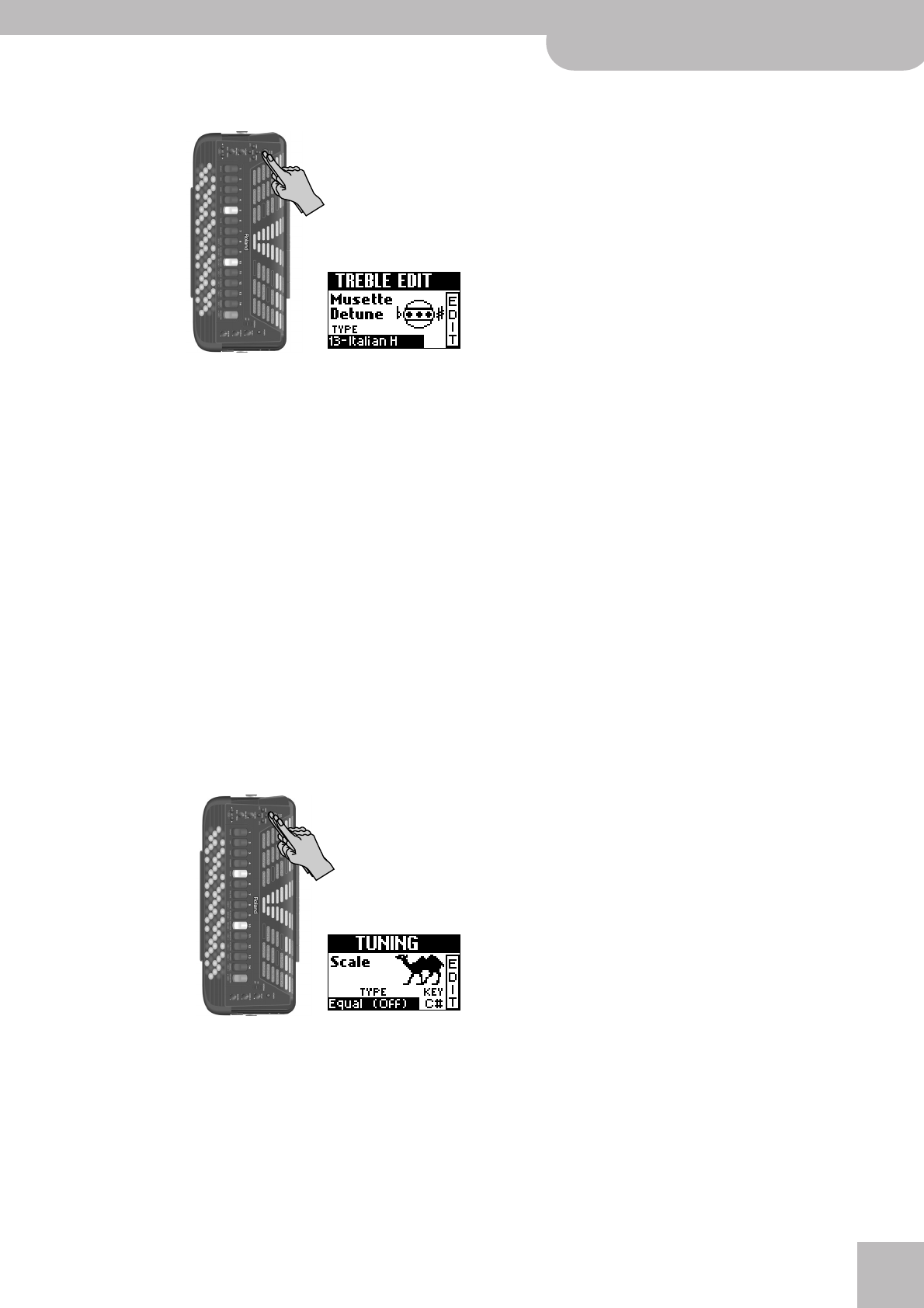
Pitch-related functions
V-Accordion
r
33
(1) While the Main page is displayed, press the [UP]
button twice.
(2) Use the [DATA÷ENTER] knob to select the a differ-
ent tuning for the Treble reeds.
The possibilities are: Off (no detune), Dry, Classic, F-
Folk, American L, American_H, North Eur, German L,
D-Folk L, Italian L, German H, Alpine, Italian H, D-Folk
H, French, Scottish.
(3) Press [EXIT÷JUMP] to return to the Main page.
■Scale (Tuning)
Almost each music culture has its own accordion
variety. Arabic, Indonesian and other musical cultures
do not use the equal temperament that is favored in
Europe, the Americas, etc.
The FR-7b/FR-5b also features a “Scale” parameter
that allows you to select the tuning system that best
fits the music you want to play. If the tuning system
you need is not among the factory settings, you can
program it yourself (see p. 42) and then select it here.
Note: See “1.1 Master Tune” on p. 42 for how to change the
FR-7b/FR-5b’s reference pitch (i.e. “really” tune it).
(1) While the Main page is displayed, press the [UP]
button three times.
(2) Use the [DATA÷ENTER] knob to select the a differ-
ent tuning system.
The possibilities are:
Equal (Off): This tuning divides each octave into 12
equal steps (intervals).
User 1~3: These settings refer to the tuning systems
programmed by yourself (or someone else). See
“1.4 Scale Edit” on p. 42 for details.
Arabic 1 & 2: As the name implies, these two set-
tings refer to Arabic tuning systems. Select “1” to
lower the E and B notes by a quarter tone (–50 cents).
“2” represents a scale where the E and A are tuned
down a quarter tone.
Just Major: This is a classical (western) tuning that
resolved the ambiguity of fifths and thirds. Quite
beautiful sonorities are produced with chords, but
the scale is unbalanced, so it is not well-suited for
melodies.
Just Minor: This is a Just scale for pieces in minor
keys.
Pythagorean: This system was invented in ancient
Greece. It resolves the ambiguity of fourths and
fifths. Though thirds are somewhat imperfect, melo-
dies sound clearer.
Mean-Tone: A temperament that adds some com-
promises to the Just temperament and facilitates
transposition.
Werckmeister: A combination of the Mean Tone and
Pythagorean temperaments, this tuning allows for
playing in any key.
Kirnberger: As a result of improvements made to the
Mean Tone and Just temperaments, it is relatively
tolerant towards transposition and can be used to
play in all keys.
Except for “Equal”, you also need to specify the root/
fundamental (“C” for major and “A” for minor)
according to the key of the song to be played.
(3) Press the [DATA÷ENTER] knob to activate the “KEY”
field (so that it is displayed in reverse).
(4) Turn the [DATA÷ENTER] knob to select the desired
root note (C~B).
(5) Press [EXIT÷JUMP] to return to the Main page.
■Noise Edit (Valve & Button)
You will probably agree that electronic sounds must
not only reproduce the basic timbre of an existing
sound, but also the original instrument’s behavior
and typical “noises” in order to be perceived as
authentic. In the case of a guitar that would be the
sliding noise of the fingers. An accordion, on the
other hand, produces mechanical valve and button
noises (clicks) that cannot be suppressed on an
acoustic instrument.
On the FR-7b/FR-5b, the volume of those noises can
be changed if you think they are too prominent or
too soft. Note that the parameters on this Jump page
belong to two different MENU sections and can be
found on separate pages: “Valve Level” is a Treble
parameter, “Button Level” is a Bass/Free Bass parame-
ter.


















